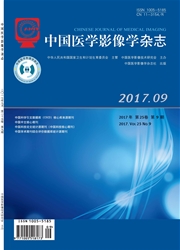

 中文摘要:
中文摘要:
目的多发性硬化(MS)具有时间、空间多发的特征,是造成青年人致残的最主要原因。本研究探讨动态对比增强磁共振成像(DCE-MRI)Tofts模型在MS中的应用价值及与临床评分的相关性。资料与方法回顾性分析25例复发-缓解型多发性硬化(RRMS)患者的临床资料,所有患者均行常规MRI和DCE-MRI检查,并应用两室Tofts模型后处理,定量分析MS患者病灶及看似正常的白质(NAWM)区的容积转移常数(Ktrans)、细胞外液间隙对比剂百分比(Ve)、内渗透系数(Kep)、脑血流量(CBF)及脑血容量(CBV),并与临床扩展残疾状态量表(EDSS)评分及病程进行相关性分析。结果 1非强化病灶区、病灶旁NAWM区与远离病灶的NAWM区两两比较,3组间Ktrans、Kep值差异有统计学意义(χ2=6.777、22.343,P〈0.05);但非强化病灶区的Ve与病灶旁及远离病灶的NAWM区差异均无统计学意义(P〉0.05);2 3组间CBF、CBV差异均无统计学意义(P〉0.05);3病程与CBF呈正相关(r=0.518,P〈0.05),其余参数与EDSS评分及病程均无明显相关性(r=-0.3710.052,P〉0.05)。结论 DCE-MRI采用Tofts模型能定量分析RRMS患者病灶及NAWM区的微血管渗透及灌注特点,准确地反映RRMS患者的血流动力学变化。
 英文摘要:
英文摘要:
Purpose Multiple sclerosis(MS) is characterized by time and spatial multiple, and it is the main reason for disabled young people. This paper aims to investigate the application of dynamic contrast-enhanced magnetic resonance imaging(DCE-MRI) with dual-compartment Tofts model in relapsing-remitting multiple sclerosis(RRMS) and its correlation with clinical scoring. Materials and Methods The clinical data of 25 patients with RRMS were retrospectively studied. The patients underwent the conventional MRI and the DCE-MRI examination. The result was processed by dualcompartment Tofts model and quantitative measurement was carried out in terms of volume transfer constant(Ktrans), rate constant between EES and blood plasma(Kep) and the volume of EES per unit volume of tissue(Ve), cerebral blood flow(CBF) and cerebral blood volume(CBV) of the lesions and normal-appearing white matter(NAWM) regions. The correlation between imaging biomarkers, expanded disability states scale(EDSS) and disease duration were also analyzed. Results 1 The differences of MR imaging biomarkers Ktrans and Kep were significant between the regions of nonenhancing(NE) lesions, the NAWM regions near NE lesions and the NAWM regions far from NE lesions(χ2=6.777 and 22.343, P〈0.05); however, Ve in the NE lesions had no significant differences compared with that in the NAWM regions near and far from NE lesions(P〉0.05). 2 The CBF and CBV among these three groups had no significant differences(P〉0.05). 3 The CBF of NE lesions was significantly correlated with disease duration(r=0.518, P〈0.05); however, the other markers like Ktrans, Kep, Ve, CBF and CBV were neither significantly correlated with EDSS nor with disease duration(r=-0.371-0.052, P〉0.05). Conclusion DCE-MRI with Tofts model can quantitatively measure microvascular permeability and perfusion characteristics of lesions and NAWM regions, which thus reflects hemodynamic changes in patients with multiple sclerosis.
 同期刊论文项目
同期刊论文项目
 同项目期刊论文
同项目期刊论文
 期刊信息
期刊信息
